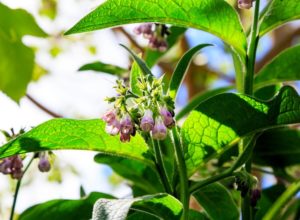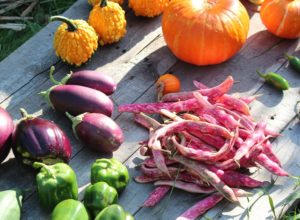[h4]
MEDITERRANEAN Climate[/h4]
Zone 0: The laundry is littered with wax from what was probably the last honey extraction for the season. Never say never though. With another unseasonally warm and dry autumn just drawing to a close, who knows what the blossoms – and hence the bees – will be up to next? Meanwhile June opens for us with a backyard produce swap – the third so far this year in our suburb, and one of many taking off across Adelaide. We also look forward to the mega-food swap event ‘Edible-izing Adelaide’ on Sunday 15th of June and its ripple effects for local home-grown exchanges.
Zone 1: Now that there’s a rainy week afoot, transplanting mixed lettuce seedlings from the shady vertical garden out to the sunny raised garden beds in the front yard. Setting up polypipe arches on sticks to support vegie-net over new brassica seedbed for protection against white cabbage butterflies (the first lot bolted to seed when autumn didn’t arrive as planned). Bush beans have now given way to bush peas as the favourite eating legumes, with snow peas coming close behind, while broad beans are going in as green manure. Worms have recovered well after being hammered in summer heatwaves. Compost bins have been moved along to areas where we plan to plant fruit trees next spring
Zone 2: The garlic that got away last year is now well on its way up again, and its time to plant the last of the crop, to be harvested towards Christmas. Self-sown bok choy and rocket have been harvested for Mum’s chooks down the road, who return the favour in eggs. Soursobs pop up regularly where the soil has been disturbed, and with the warm weather some are flowering already. The bees don’t mind – though they can be pulled out with as little disturbance as possible and replaced with vegies before they have a chance to recover. The frame for a future chook enclosure is slowly taking shape, while pear trees are being trained into shape ready to give those chooks summer shade. Apple trees are enjoying the ‘rocks in socks’ treatment to bring their branches closer to the horizontal and encourage fruiting spurs.
Zone 3: Fruit tree prunings that have been piled in a heap awaiting time to chop them up have done a fine job of suppressing weeds on the mulched path – hence now being rolled around to a fresh patch every so often to continue their good work. The sticks will gradually be used as stakes for peas and broad beans, and then for next summer’s tomatoes and beans. Herbs and native ground covers that have grown leggy are trimmed back and the cuttings distributed to neighbours’ and friends’ gardens. Grapevines that had covered a northern pergola and then the roof have been pruned back just before they took over the PV and solar hot water systems. Grape cuttings strike readily. The plants grown from last year’s cuttings will be ready to plant out into other gardens this winter.
Zone 4: Succulent pigface (carpobrotus glaucescens) has served its pioneering purpose on the road verge, gradually converting clay and dolomite to more fertile soil by providing shade and collecting windblown mulch over the past few years. It’s now gradually being replaced with a wider range of resilient but less rampant native ground covers and shrubs.
Zone 5: Being suburban, we have no truly wild area on our doorstep, but the quieter gardening time now allows us to schedule some regular bushwalks, for recreation and observation. This month started with Morialta Conservation Park, celebrating recent rain with a walk to the waterfalls.
Nadja Osterstock
www.nadjasgarden.com.au
Facebook www.facebook.com/pages/Nadjas-Garden/147773922060096
[h4]
TROPICAL climate[/h4]
Zone 0: The slightly cooler temperatures are a welcome relief and time to reduce the feeding to the worm farm. Their activity will be a little reduced in the cooler weather. The presence of vinegar flies will alert you to unprocessed food accumulating. A sprinkle with lime or dolomite and a stir of the contents may assist in reducing the population of flies. It is still too hot in the sun for the worms particularly if they are in a black farm as most of them are. Now is the time to make flavoured vinegar with the lemon myrtle.
Zone 1: Continue planting the European style annual vegetables including onions. The higher temperatures may enable the onions to have a strong growing period before a cold spell initiates their bulb formation.
Zone 2: If it’s looking like a long cooler dry season then it may be worth trying for a crop of brown onions which will store well for use during the dry season. I have produced onions in the past but never with the long keeping qualities. I mainly use garlic chives as these thrive no matter what. My purple yams were still growing strongly due to the ongoing rain and high temperatures but I harvested them anyway as I wanted the area to prepare for beans and peas. I am also trying a serpent gourd this year. It sounds similar to the guada bean. The fruit, leaves and growing tips can be eaten according to the seed packet. I love trying something new but it has to survive my style of gardening. This is generally referred to as set and forgets. If you work with a chook tractor continue to use them to clean up the wet season gardens prior to planting the next crops.
Zone 3: Keep harvesting the weeds and overgrowth as compost and mulch. I make piles of the weeds under the drip lines of some of the trees and this decomposes over time making slow release fertiliser. Next year the drip line will be a little further out and I do the same on the new drip line. This effectively removes the weed competition from the area used by the feeder roots for the tree.
Zone 4: Now is a good time to do any major reconstruction, tree planting or relocating. The ground is still fairly soft and workable and the weather is a little less fierce.
Zone 5: There is not a lot of active work in this area. Just make sure the postman can get along the foot path without taking out an eyeball or being hung up in a branch and enjoy the ongoing display of Riberry flowers. Harvest when ripe for the most unctuous spread you can make. Make sure the mulch is thick and preventing any weed growth. You can harvest the lemon myrtle leaves all year but the cooler temperatures can be a great time for the drinking of hot lemon myrtle tea.
Kathleen Hosking
www.solutionfocused.net.au









